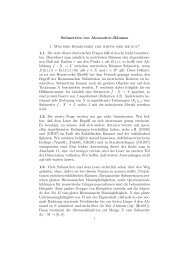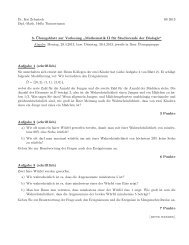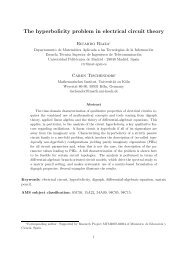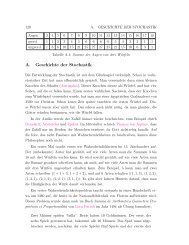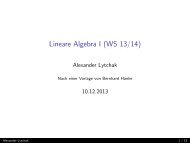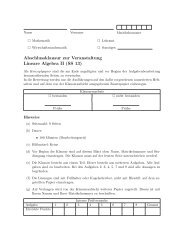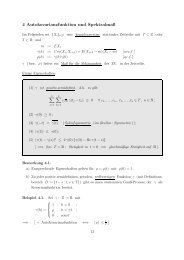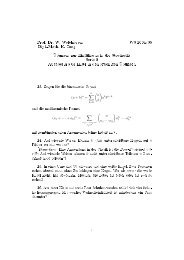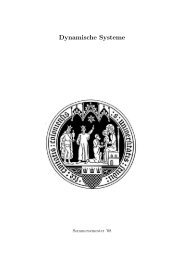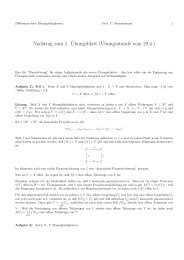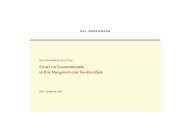Inhaltsverzeichnis - Mathematisches Institut der Universität zu Köln
Inhaltsverzeichnis - Mathematisches Institut der Universität zu Köln
Inhaltsverzeichnis - Mathematisches Institut der Universität zu Köln
Create successful ePaper yourself
Turn your PDF publications into a flip-book with our unique Google optimized e-Paper software.
DMV Tagung 2011 - <strong>Köln</strong>, 19. - 22. September<br />
Sören Häuser<br />
Technische <strong>Universität</strong>, Kaiserslautern<br />
Shearlet coorbit spaces: traces and embeddings<br />
In recent years it has turned out that shearlets have the potential to retrieve directional information so<br />
that they became interesting for many applications. Moreover the shearlet transform has the outstanding<br />
property to stem from a square integrable group representation. This remarkable fact provides the opportunity<br />
to design associated canonical smoothness spaces, so-called shearlet coorbit spaces by applying<br />
the general coorbit theory <strong>der</strong>ived by Feichtinger and Gröchenig. However, once these abstract smoothness<br />
space are established some natural questions arise. Of course one would like to know how these<br />
spaces look like and how they are related to other known classical smoothness spaces such as Besov<br />
or Triebel-Lizorkin spaces. Moreover, one would like to un<strong>der</strong>stand the structure of these new spaces.<br />
That is, it would be desirable to know how these new scales of shearlet coorbit spaces behave un<strong>der</strong><br />
embeddings and trace operations.<br />
In this talk we examine structural properties of shearlet coorbit spaces in higher dimensions. We prove<br />
embedding theorems for subspaces of shearlet coorbit spaces resembling shearlets on the cone in<br />
three dimensions into Besov spaces. The results are based on general atomic decompositions of Besov<br />
spaces. Furthermore, we establish trace results for these subspaces with respect to the coordinate<br />
planes. It turns out that in many cases these traces are contained in lower dimensional shearlet coorbit<br />
spaces. To prove these results we apply the concept of coorbit molecules recently developed by Gröchenig<br />
and Piotrowski.<br />
Joint work with S. Dahlke (Philipps-<strong>Universität</strong> Marburg), G. Steidl (Technische <strong>Universität</strong> Kaiserslautern)<br />
and G. Teschke (Hochschule Neubrandenburg).<br />
Lutz Kämmerer<br />
Technische <strong>Universität</strong> Chemnitz<br />
Stable interpolation of hyperbolic cross trigonometric polynomials<br />
A straightforward discretisation of high-dimensional problems often leads to an exponential growth in the<br />
number of degrees of freedom. So, computational costs of even efficient algorithms like the fast Fourier<br />
transform increase similar.<br />
Trigonometric polynomials with frequencies only supported by hyperbolic crosses allow for a good approximation<br />
of functions of appropriate smoothness and decrease the number of used Fourier coefficients<br />
strongly. As a matter of course, an important issue is the customisation of efficient algorithms to these<br />
thinner discretisations.<br />
Sparse grids are the natural discretisations in the spatial domain. The corresponding Fourier transform<br />
suffers from stability problems. For that reason we consi<strong>der</strong> sets produced by multiples of a so-called<br />
generating vector as spatial discretisations. Therewith an easy and fast evaluation of trigonometric polynomials<br />
at the grid nodes is guaranteed. Some additional assumptions ensure even stability and besides<br />
the fast reconstruction of trigonometric polynomials from the function values. We discuss necessary and<br />
sufficient conditions allowing for the stable reconstruction.<br />
115




